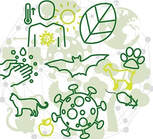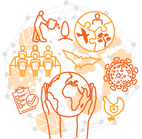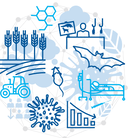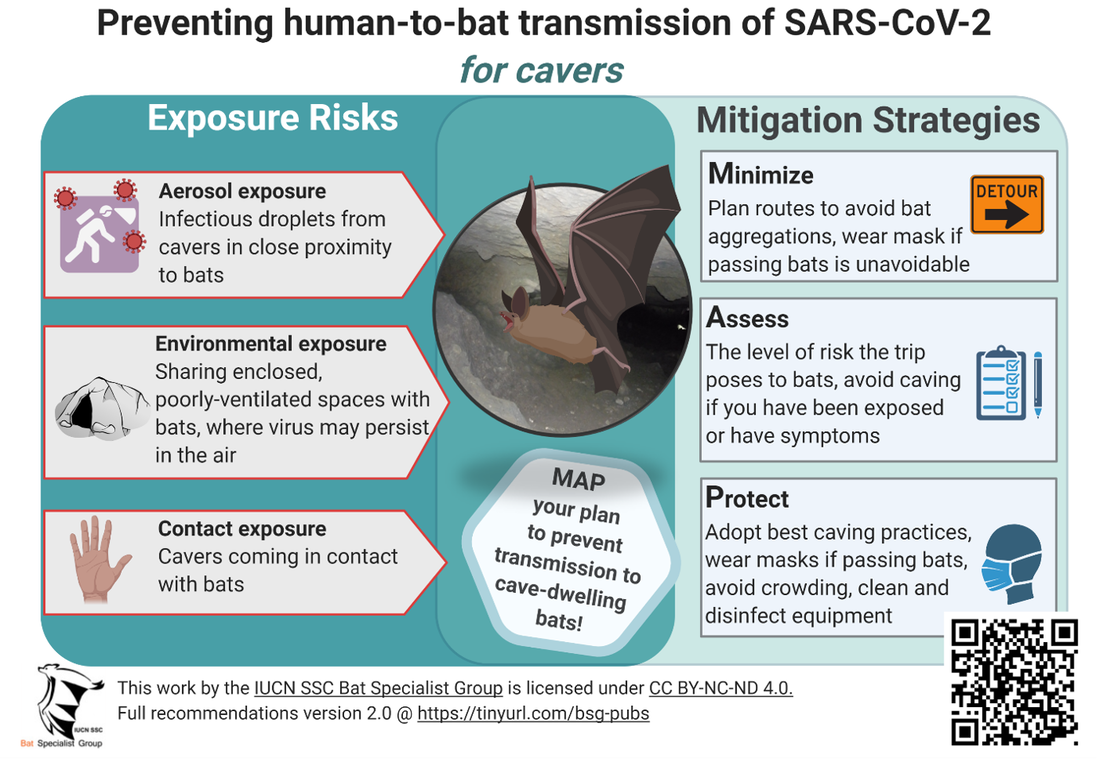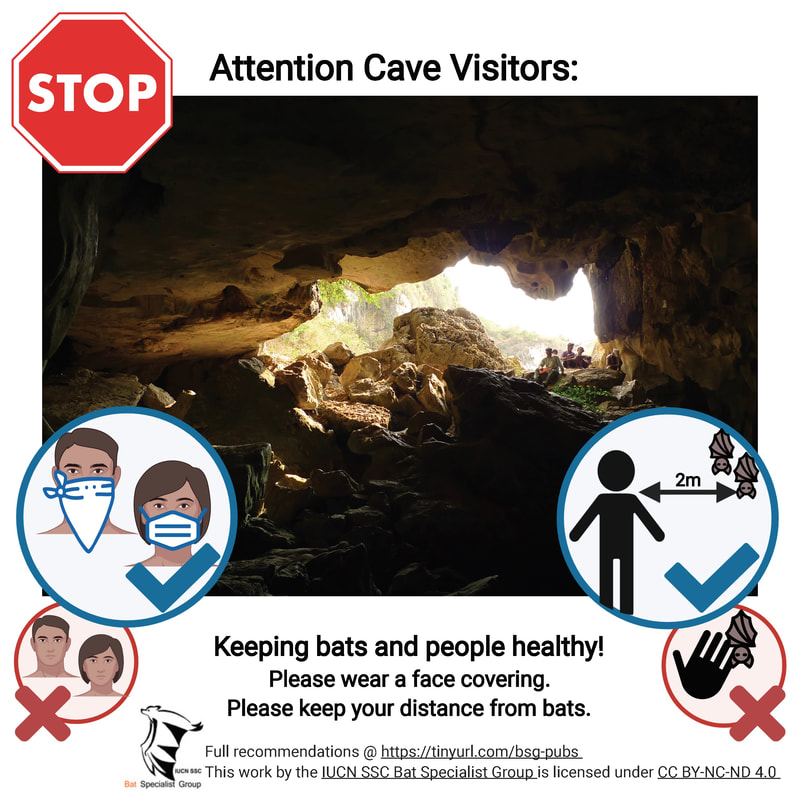Protecting Bats From COVID-19
June 2024 Update: The BSG OneHealth Working Group (formerly the Working Group on Human-Bat Transmission of SARS-CoV-2) has continued to meet regularly since 2020. We have now released our guidelines for Field Hygiene that should be that we ask all researchers doing fieldwork with bats to follow. These guidelines are meant for work during all "ordinary" circumstances and aim to minimize the risk of pathogen transmission in all directions - humans to bats, bats to humans, and between bat species or populations, facilitated by humans.
Other stakeholders (bat rehabbers / rescuers, cavers, guano collectors) should continue to follow our most recent guidelines and recommendations:
1. Recommendations for Cavers v.2.0 (June 2021) fully replaces v.1.0, but continues to use the MAP Strategy – Minimize, Assess, Protect.
2. Recommendations for Rescue and Rehabilitation Centers v.2.0 (June 2021) fully replaces v.1.0, but continues to use the MAP Strategy – Minimize, Assess, Protect.
Guidelines for guano collectors remain unchanged but updates are expected in 2024 - 2025. All up-to-date guidelines can be found below.
Cavers
IUCN SSC Bat Specialist Group (BSG) recommendations to reduce the risk of transmission of SARS-CoV-2 from humans to bats by cavers MAP: Minimize, Assess, Protect
Living Document Version 2.0 Released 22nd December 2021
Authors (in alphabetical order): Winifred Frick, Tigga Kingston, Stefania Leopardi, Rodrigo Medellín, Ian H Mendenhall, Paul Racey, Julie Teresa Shapiro, Amanda Vicente-Santos, Luis Viquez-R, and Lisa Worledge.
Overview
The recommendations below have been conceived specifically to modify caving practices to protect bats from accidental SARS-CoV-2 exposure and transmission from cavers. However, under all circumstances cavers should avoid disturbing bats and follow existing best practice. The panel recognises that our understanding of SARS-CoV-2 is changing rapidly and advises the speleological community that this is a living document with updates anticipated.
You can download a PDF version of the full document and accompanying visuals for cavers below.
Living Document Version 2.0 Released 22nd December 2021
Authors (in alphabetical order): Winifred Frick, Tigga Kingston, Stefania Leopardi, Rodrigo Medellín, Ian H Mendenhall, Paul Racey, Julie Teresa Shapiro, Amanda Vicente-Santos, Luis Viquez-R, and Lisa Worledge.
Overview
The recommendations below have been conceived specifically to modify caving practices to protect bats from accidental SARS-CoV-2 exposure and transmission from cavers. However, under all circumstances cavers should avoid disturbing bats and follow existing best practice. The panel recognises that our understanding of SARS-CoV-2 is changing rapidly and advises the speleological community that this is a living document with updates anticipated.
You can download a PDF version of the full document and accompanying visuals for cavers below.
Bat Researchers
Researchers should now refer to our general Field Hygiene guidelines.
Bat Rescuers and Rehabbers
IUCN SSC Bat Specialist Group (BSG) recommendations to reduce the risk of transmission of SARS-CoV-2 from humans to bats in bat rescue and rehabilitation centers MAP: Minimize, Assess, Protect.
Living Document Version 2.0 Released 30th June 2021
Authors: Tracey Jolliffe; Andrzej Kepel; Tigga Kingston; Stefania Leopardi; Jenny Mclean; Ian H Mendehall; Stuart Parsons; Danilo Russo; Julie Teresa Shapiro; Luis Víquez-R; Lisa Worledge.
Overview
The following recommendations have been developed to encourage and assist bat experts and enthusiasts involved in bat rescue and rehabilitation around the world to prepare and implement these mitigation strategies. Special guidelines concerning SARS-CoV-2 should be included in the general framework of health and safety at facilities involved in bat rescue and rehabilitation, and take into account all regional risks, capabilities and regulations.The panel recognises that our understanding of SARS-CoV-2 is changing rapidly and advises the bat rescue and rehabilitation community that this is a living document with updates anticipated.
You can download a PDF version of the full document and accompanying visuals for Bat Rehabilitation below.
Cave Visitors and Guano Collectors
Information for guano harvesters
The Bat Specialist Group recognizes that bat guano is an important source of income for people around the world. To reduce the risk of transmission of SARS-CoV-2 from people to bats, we recommend that harvesters stay at least 2m from bats and cover their nose and mouth with a mask or scarf. Further guidelines for minimizing the negative impact to bats from guano harvesting are available here https://tinyurl.com/guanoguide
The Bat Specialist Group recognizes that bat guano is an important source of income for people around the world. To reduce the risk of transmission of SARS-CoV-2 from people to bats, we recommend that harvesters stay at least 2m from bats and cover their nose and mouth with a mask or scarf. Further guidelines for minimizing the negative impact to bats from guano harvesting are available here https://tinyurl.com/guanoguide
Information for cave visitors
Caves attract visitors of all kinds around the world. To reduce the risk of transmission of SARS-CoV-2 from cave visitors to bats, the Bat Specialist Group recommends that visitors stay at least 2m from bats and cover their nose and mouth with a mask or scarf.
Caves attract visitors of all kinds around the world. To reduce the risk of transmission of SARS-CoV-2 from cave visitors to bats, the Bat Specialist Group recommends that visitors stay at least 2m from bats and cover their nose and mouth with a mask or scarf.
Downloadable PDF versions of Infographics:
Previous Versions
Bat Researchers
Here you can find the previous guidelines. These are for reference. Please follow the most recently issued guidelines (above).
IUCN SSC Bat Specialist Group (BSG) Recommended Strategy for Researchers to Reduce the Risk of Transmission of SARS-CoV-2 from Humans to Bats AMP: Assess, Modify, Protect
Living Document Version 2.0 Released 02 July 2021
Authors v. 2.0 update: Tigga Kingston, Winfred Frick, Rebekah Kading, Stefania Leopardi, Rodrigo Medellín, Ian H Mendenhall, Paul Racey, Julie Teresa Shapiro, Amanda Vicente-Santos, Luis Víquez-R, Lisa Worledge.
IUCN SSC Bat Specialist Group (BSG) Recommended Strategy for Researchers to
Reduce the Risk of Transmission of SARS-CoV-2 from Humans to Bats
MAP: Minimize, Assess, Protect
Living Document Version 1.0 Released 19th June 2020
Authors: Germán Botto Nuñez, Andrew Cunningham, Eric Moise Bakwo Fils, Winfred Frick, Md
Nurul Islam, Tracey Jolliffe, Rebekah Kading, Andrzej Kepel, Tigga Kingston, Stefania Leopardi,
Rodrigo Medellín, Ian Mendenhall, Stuart Parsons, Paul Racey, Danilo Russo, Julie Teresa Shapiro,
Amanda Vicente-Santos, Luis Víquez-R, Thong Vu Dinh.
Decision Tree for Bat Researchers
Note: This decision tree corresponds with Version 1.0 of the Guidelines for Researchers.
Downloadable Covid-19 Visual for Researchers - Decision Tree
Please note you can click thru the slideshow to see Decision Tree pages.
Please note you can click thru the slideshow to see Decision Tree pages.
| iucn_bsg_map_decision_tree_for_researchers_final.pptx | |
| File Size: | 73 kb |
| File Type: | pptx |
